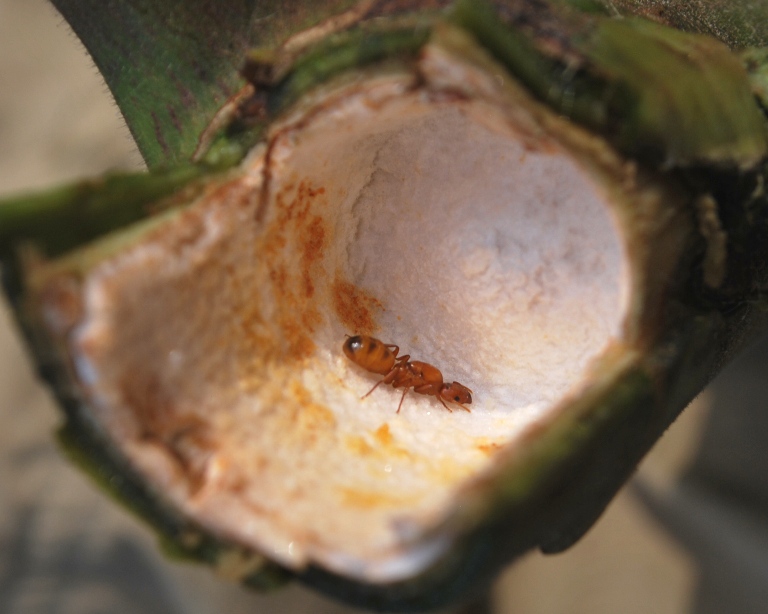Ant quiz and ants of Ecuador
2 posters
Page 1 of 1
 Ant quiz and ants of Ecuador
Ant quiz and ants of Ecuador
On the website of the ants of Tiputini by Kari T. Ryder Wilkie, you can find a quiz for which you can test your knowledge on the different subfamily of the ants present in Ecuador.
Beside that the website present her work in Ecuador and is a great resource for people interested in ants of South America.
I was also really amazed by the new ant trap that she designed: "the subterranean probe" to collect hypogaeic ants. The description can be found on her website and the results were published in Naturwissenschaften (2007) 94: 725-731 under the title: Biodiversity below ground: probing the subterraneanant fauna of Amazonia.
Here is the abstract:
Ants are abundant, diverse, and ecologically dominant in tropical forests. Subterranean ants in particular are thought to have a significant environmental impact, although difficulties associated with collecting ants underground and examining their ecology and behavior have limited research. In this paper, we present the results of a study of subterranean ant diversity in Amazonian Ecuador that employs a novel probe to facilitate the discovery of species inhabiting the soil horizon. Forty-seven species of ants in 19 genera, including new and apparently rare species, were collected in probes. Approximately 19% of the species collected at different depths in the soil were unique to probe samples. Analysis of similarity (ANOSIM) results showed that the species composition of ants collected with the probe was significantly different from samples collected using other techniques. Additionally, ANOSIM computations indicated the species assemblage of ants collected 12.5 cm below the surface was significantly different from those found at 25, 37.5, and 50 cm. Ant diversity and species accumulation rates decreased with increasing depth. There were no species unique to the lowest depths, suggesting that subterranean ants may not be distributed deep in the soil in Amazonia due to the high water table. The technique we describe could be used to gain new insights into the distribution and biology of subterranean ant species and other members of the species rich soil invertebrate macrofauna.
Beside that the website present her work in Ecuador and is a great resource for people interested in ants of South America.
I was also really amazed by the new ant trap that she designed: "the subterranean probe" to collect hypogaeic ants. The description can be found on her website and the results were published in Naturwissenschaften (2007) 94: 725-731 under the title: Biodiversity below ground: probing the subterraneanant fauna of Amazonia.
Here is the abstract:
Ants are abundant, diverse, and ecologically dominant in tropical forests. Subterranean ants in particular are thought to have a significant environmental impact, although difficulties associated with collecting ants underground and examining their ecology and behavior have limited research. In this paper, we present the results of a study of subterranean ant diversity in Amazonian Ecuador that employs a novel probe to facilitate the discovery of species inhabiting the soil horizon. Forty-seven species of ants in 19 genera, including new and apparently rare species, were collected in probes. Approximately 19% of the species collected at different depths in the soil were unique to probe samples. Analysis of similarity (ANOSIM) results showed that the species composition of ants collected with the probe was significantly different from samples collected using other techniques. Additionally, ANOSIM computations indicated the species assemblage of ants collected 12.5 cm below the surface was significantly different from those found at 25, 37.5, and 50 cm. Ant diversity and species accumulation rates decreased with increasing depth. There were no species unique to the lowest depths, suggesting that subterranean ants may not be distributed deep in the soil in Amazonia due to the high water table. The technique we describe could be used to gain new insights into the distribution and biology of subterranean ant species and other members of the species rich soil invertebrate macrofauna.
 Re: Ant quiz and ants of Ecuador
Re: Ant quiz and ants of Ecuador
I had a wonderful opportunity in January to spend two weeks in a locality near where Kari did her survey. I only saw about 100 or so of the ants on her list, plus a number that live in plants that were not on her list, like this beautiful Azteca queen in a Cecropia stem:


James C. Trager- Number of posts : 28
Location : Missouri, USA
Registration date : 2008-02-25
 Similar topics
Similar topics» Useful ants
» Books on ants
» Ants' laboratory around the world
» Book on Ants of Colombia
» The Genome Size of Ants
» Books on ants
» Ants' laboratory around the world
» Book on Ants of Colombia
» The Genome Size of Ants
Page 1 of 1
Permissions in this forum:
You cannot reply to topics in this forum